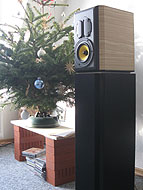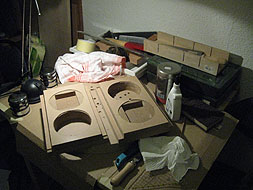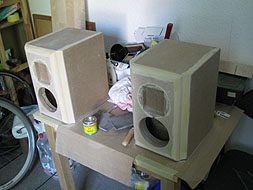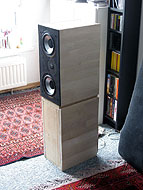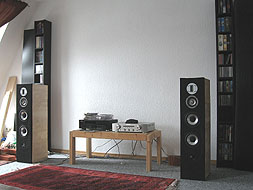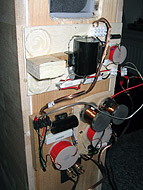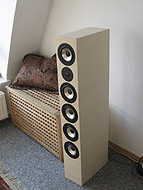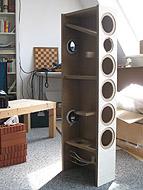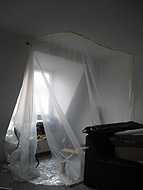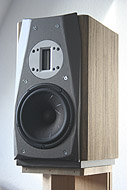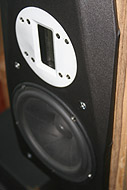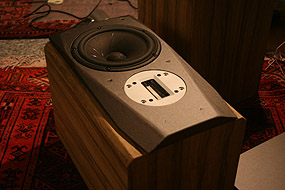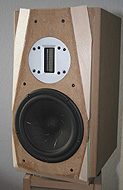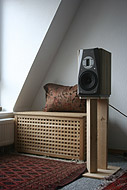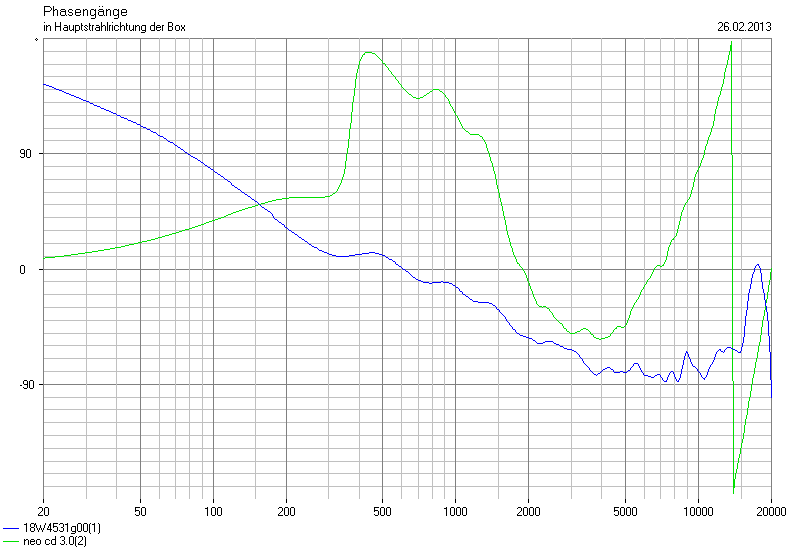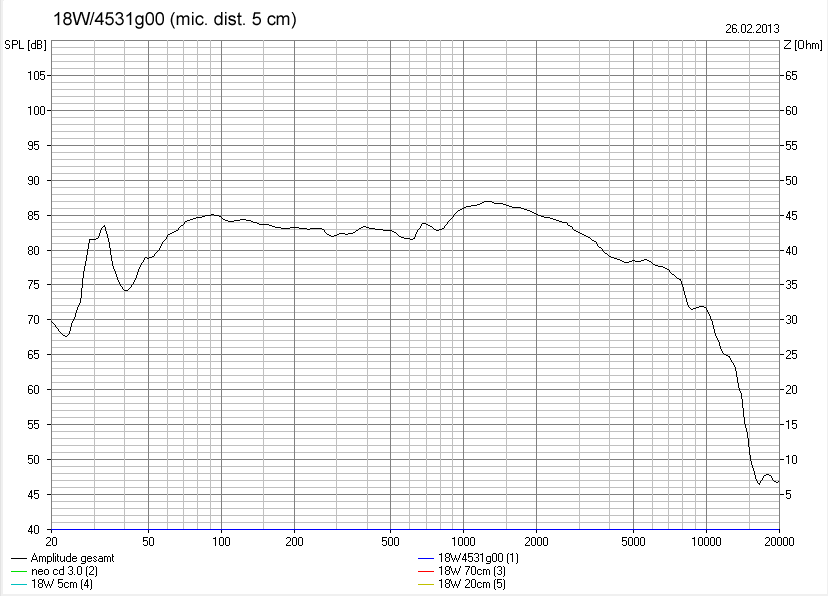Introduction
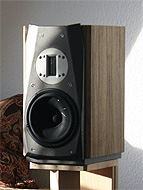
On this page you will find reports on some of the DIY loudspeakers I build. "The Bat" is the only speaker designed by me, all others are executions of existing designs. Please keep in mind that I am just an enthusiastic hobbyist. I am aware that there a few highly subjective, maybe even questionable statements on this page. However, I especially find such subjective accounts from other people very interesting and useful, and do not expect to be all alone with this. It's about inspiration and sharing experiences. I trust and advice readers to make up their own minds!
Contents:
Zaph Krutkes BAMTM (Dayton DA175-8 + Seas 27TBFC/G)
VISATON Quintett (VISATON 4x AL130 + AL130 + KE25SC)
The Bat (Scanspeak 18W4531G00 + Fountek NeoCD3.0)
Swans M1 (HiVi F5 + RT1C-A)
Motivation:
This was my first DIY speaker build. I came from listening to Monitor Audio BR 5s. I wanted less bass and a non-dome tweeter (because I was missing the treble of my old Infinities). I stumbled upon a review of the Swans M1, which made me curious. I also found the Swans M1 thread on hifi-forum.de and learned that the drivers were individually available as were the crossover and enclusure plans. Now a pair of retail Swans M1 sets you back 1400 Euros - or 2200 Euros for the high-end version. The parts for a DIY clone amounted to 350 Euros/pair. I have to admit, this seemed such a good deal to me, that I was sold on the idea of building them. Sometimes good things happen for bad reasons.
Impressions:
I really liked the voicing of the M1. Lots of midrange and treble detail, yet easy to listen to. Shy on bass, as was to be expected. Great with piano and female voices. A bit less so with male voices. Orchestral scores were great. Coldplay and a-ha produced a nice sound. However, I found out that I stopped listening to metal albums altogether with these speakers. Widehorizontal dispersion. Even when sitting far outside of the stereo triangle imaging was still quite good. Narrow vertical dispersion: less floor reflections, but if you were standing upright or sitting on te floor, treble was reduced significantly.
Lessons learned:
DIY speakers: wood-working and soldering has been fun. Value is high, acoustically I was more happy with the M1 than with my MA speakers. Now I was curious what else would be possible. On to the next project!
Cabinet damping is a weird thing. In this case I experimented with various materials: yellow fibre stuffing from disassembled Canton Speakers, egg-crate-foam, basotect. When music material excited the cabinet resonance frequencies, it was audible and not in a good way. But this was only really evident with some special music pieces. Applying damping material reduced this effect significantly. However, adding more damping material seemed to suck out the life from musical presentation. I remember having read something similar in a B&W paper. So perhaps they have a point there and their sphere/tube construction is not just a marketing gag like some people on the internet forums want to suggest.
Sounding: regardless what reviews and marketing texts say. This is not a neutral speaker. There ist nearly no baffle-step compensation, and there is an interesting discrepancy between the swans measurements and those of hifi-test.de. However, there is something about the midrange voicing that sounds really good to my ears.
HiVi drivers: Short story: I really liked them, both visually and acoustically. My only critique would be the vertical dispersion of the RT1C-A. Otherwise, it is very to close to my other favorite tweeter the Fountek NeoCD 3.0. With acoustical guitars the HiVi sounded a bit more *pling*, where the Fountek sounded a bit more *zing*, but I have no idea if that was an effect of voicing or something else.
Recommendation:
If you have a small room, close to the wall placement, angry neighbours, and taste for a presence band elevation (2 to 4kHz), you might like the M1. You have also have to like the limited bass, or plan on using one or two subwoofers. Although I haven't tried the latter, other people report to be very happy with this kind of setup. Final warning: the M1 is good, but certainly not for everyones taste. Building without listening in advance is high-risk. At least one builder on hifi-forum.de was very disappointed.
Zaph Krutkes BAMTM (Dayton DA175-8 + Seas 27TBFC/G)
Original design at Zaph|Audio, Author: John "Zaph" Krutke
Motivation:
Building a well-known design from Zaph (John Krutke) the Bargain Aluminum MTM, featuring: low-distortion seas metal-dome tweeter, low distortion budget woofers, D'Appolito configuration. The woofers were cool because they promised to work in 30 litres closed-box, 60 litres closed-box and 60-litres ported. Being able to test three different bass alignments with one speaker would be an interesting lesson. Evaluating the the DA175s and bass alignment in preparation for the Bargain Mini Statements project.
Impressions:
This is supposed to be a very neutrally voiced speaker. Nothing stands out, nothing is missing. I found them to play very well with a wide range of musical styles. A bit bland compared to the M1, but the speakers have a point being that way.
Lessons learned:
D'Appolito: A bit more forward sounding is what some people say. It does. What I didn't liked about it: both narrow vertical and horizontal sweet spot. The narrow horizontal sweet spot might have been due to the fact that I did very little to chamfer the edges of the baffle as Zaph suggested.
Countersunk tweeter: out of curiosity I tried to use the tweeter non-countersunk. It was clearly audible and it sounded wrong, like a significant part of treble was missing.
Low distortion drivers: a bit what I had hoped for: very comfortable to the ears, even with long listening sessions. I had the impression that the lack of distortion, made me crank up the volume higher than usual. At reasonable volumes the four DA175-8 did quite well with big drums, this is a point were the Hivi F5 failed miserably (probably most drivers of that size will do).
Using just any kind of wood: I used different kinds of left-over wood (birch and spruce, if I remember correctly) and this wasn't a good idea. The cabinets where a little bit too shaky - this was somewhat audible as kind of tremor in "Enya - May it be". Conclusion: if you plan an elaborate build, try sticking to materials that are known to work well for speakers. Birch is actually quite well-suited, but the other one clearly wasn't. I padded the inside with 4mm bitumen and 1" of acoustic foam, but this didn't help much. If might have been that stuffing was insufficent and the audible resonances a likely consequence. Would have been nice if I could have done impedance measurements at the time.
Bass alignment: 60 litres closed box was the winner. 60l ported excited the room (25qm) too much for my taste, 30l CB was too boomy (Qtb gets too high, I assume). I assume that the high placement of the bass drivers also had something todo with the good in-room response.
Recommendation:
A really allround decent speaker, very balanced - if you don't like this speaker, you probably don't like a neutral voicing or want your high-distortion speakers back. Nothing wrong with that from my point. There are speakers who sound more detailed at low volume. Keep in mind what I wrote regarding the sweet spot. If you're looking for fullrange system on a budget or a promising, low-complexity first-time project I can recommend the BAMTM. Although the drivers are inexpensive it is worth giving the cabinet work some love. Oh, yes, they are definetely no small speakers.
The Bargain Mini Statements (a variant of Jim Holtz's Mini Statements) (2x Dayton DA175-8 + Tangband W4-1337SA + Fountek NeoCD3.0)
Original design at speakerdesignworks.com, Author: Jim Holtz
Motivation:
Trying the Fountek ribbon and the W4-1337, very popular drivers in the DIY community. Merging the enjoyable low-level performance of the 60 litre closed box BAMTMs with the tweeter/mid-combo of the mini-statements.
Impressions:
Even though the DA175 are 2db less efficient than the RS180, it was still too much low end. I expect this design to function a lot better in a spacious dry-walled living room. In a 25qm concrete wall living room it is a bit misplaced in my opinion. I bridged the 1 ohm resistor in series to the mid and it was a bit better.
Lessons learned:
"Detail": the Mini Statements are a good example of how misleading the term "detail" can be. On closer inspection the midrange driver is playing only half as loud as the deep bass or extended treble. I have no doubt that at high volumes this speaker plays all the "detail" in a smooth way, but at low levels the midrange is just too recessed for my taste to make out the interesting parts of the music material.
Crossover, low pass: it was clear from the beginning, that the original XO most likely wouldn't work with the DA175s. I tried anyway and came out with something that made Manowar sound like Kindergarten. With the help of downloaded impedance data and primitive acoustical measurements I tried some variations. The basics problem with two DA175s and a big (>100uF) capacitor in parallel the impedance at 130Hz can easily drop below 3.0 ohms. My amp, a marantz PM 5004, didn't like this at all, it simply juiced out less current than the speaker required at the relevant frequency range. There is a similar design on the parts-express forums, featuring twin DA175 in a low crossover configuration. The solution: adding a 1 ohm resistor in series. I tried that, but the DA175 usually have a qts > 0.5. With the 60 litre enclosure I was a good way into the acceptable zone. However, the effective reduction of enclosure volume by adding the necessary midrange TML was more than expected. The space between side walls and the TML canal probaby wasn't wide enough. So, we have high Qts woofers, an enclosure that is already bordering on too small and then we add a 1 ohm resistor in series. I eventually came up with a reasonably balanced voicing, but the bass performance was still abysimal.
Midrange TML: a love-hate relation ship. Basically, I was very fond of the idea of not having a closed box midrange enclosure. Mainly because of the damping material frustration with the M1. But I was constantly experimenting with speaker-to-rear-wall-distance and adding/removing some foam inside the TML. It all had its benefits and drawbacks. In the end I kept being uneasy that part of the response was by dipole and part was not. Perhaps it was something else that was irritating me, but it's hard to say.
Fountek NeoCD3.0: Love it! Better vertical dispersion than the Hivi RT1C-A. I understand why people make statements like "good enough for home cinema, but insufficent for music listening", but it can also be the other way around: When blades meet, ceramic shatters or windows burst the NeoCD3.0 is incredible. That is something the dome tweeter I had just don't do that way. Applauding audience is also a good indicator of a tweeters capabilities - really amazing. There might be things the 27TBFC/G or the KE25SC do better but I somehow prefer the NeoCD3.0 a lot and also the RT1C-A. This might be different at higher playback levels, but that's something I usually cannot afford to.
Cabinet suck Pt. II: Basically I inherited the problems of the BAMTM build. At least the resonances evident with "Enya - May it be" were gone, the midrange was now handling the relevant frequencies. Refitting the speaker with a midrange TML was a nasty business and I was not completely happy with the constructions. Still a bit shaky, and the midrange TML had a possibly early reflecting inner edge due to my construction.
Tangband W4-1337: Mixed feelings. I liked it when playing fullrange without a crossover. At least with certain music like "Eric Clapton - Unplugged". The short-comings of doing so are obvious (nearly no bass, no baffle-step-compensation), but it was a lively sound and there was something to enjoy. With the mini-statement crossover the W4 was far too subdued for my taste. Another thing: when listening full-range, off-axis to a single W4 I found the sound somewhat weird and very unnatural. Off course you will have a non-ideal response at 70cm, 60° off axis. And I couldn't measure it at the time. However, other midwooders (F5, AL130, DA175, 18W4531g00) sounded just a bid recessed in treble when doing so, but not weird. Perhaps it has something to do with the steep cone profile, I don't know. Usually, when I get a new driver I put it on a thick rug, hook it directly to the amp, play some music or tone signals and walk around the room. Maybe applying a bit equalisation. You might shake your head at the approach, but I usually find that this method conveys a lot of sonic qualities that prevail even when the response is significantly shaped by the crossover.
Recommendation:
It is hard to say. This was a half-heartedly modification of the Mini Statements. And its impossible to say how the modification changed the overall performance. Cabinet execution wasn't good either. All I can say, take a good look at the frequency response at speakerdesignworks.com and ask youself if that is really what you want to have. Try to silence your 'want have!' child for a few seconds ;) Don't get me wrong: this is a question of what listening room you have and of your personal taste. If midrange tends to grind your ears, you have a big room, maybe drywall construction, you like playing loud, but not very loud, the mini statements could be for you. My biggest complain was low speech intelligibility. Even with the subdued playback level I had expected more from the W4 wide-band contribution. Again this could also trace back to poor execution on my part.
VISATON Quintett (VISATON 4x AL130 + AL130 + KE25SC)
Original design at VISATON
Motivation:
Trying the highly praised drivers VISATON KE25SC and AL 130. See how much low end response you can get from four 5" midwoofers. Using four woofers per side promissed a more even bass response by smearing the floor-bounce. Two different cross-overs available (Klang & Ton (XO @ 270 & 2500 Hz), Visaton (XO @ 500 & 4000 Hz). Liked the design visually a lot.
Impressions:
Both KE25SC were less efficient than specified, about 2 to 3 db in their operating range. Which is pretty bad for the price in my opinion. I had to design a new crossover for the tweeter (this time with all required measuring equipment). I still have to send these tweeters to VISATON to make sure they aren't defective. The break up resonance of the mid is only -14db down according to my measurements and simulations. With critical listening this wasn't so bad, and it was perfectly okay for home-cinema. But when I am listening to music while working and find myself dialing down the volume until the music is barely audible, that doesn't speak well for the design. Actually, this was even worse than with my old Monitor Audios. Crossing 12dB @ 4000 Hz with a 5" hard-coned woofer is not especially straightforeward. I used a tank-circuit to tame the resonance and it was a lot better then. The low-end performance of the Quintett was very impressive. Following an advise from Pico (www.hifi-selbstbau.de) I modified the impedance control branch of the woofer circuit yielding a much cleaner and tighter response. However, the VISATON configuration has its own merits, once again a matter of individual taste.
The VISATON Quintett sounds similiar to the BAMTM, but is clearly the better speaker in several areas. More low-end-punch, significantly better off-axis-listening and an overall better resolved sound. Actually, that is the minimum to be expect given the price point of the Quintett materials (for me the pair was a 1200 Euro investment).
Sometimes with certain piano recordings I had some rare occasions were something sounded broken. I wasn't able to reproduce this and have no idea were it might come from. But it definitely increased my suspicion about the state of the tweeters.
The VISATON Quintett was a great home cinema speaker, but unfortunately it is one of the speakers were I stop listening to music alltogether without really being able to pinpoint the issue.
Lessons learned:
KE25SC: I have yet to listen to them in a different concept. Also, something might be wrong with my units. They seemed to be a bit more edgy than the 27TBFC/G.
AL130: Midrange qualities were good, but not better than the Hivi F5. But they are really very good 5" woofers, they go really low. In the future I will try using them in a configuration similar to the Hobby Hifi Cento. This will probably be enough low-level output for my taste. I measured up to 2 dB variation at 2,5kHz which is totally in the passband of the Quintett's mids. The good thing is, when you've got a decent microphone you can select matching midranges. If not... :(
Mission DIY possible: Rightmost pic above: woodworking in the living room. Setting up this tent took 45 minutes including moving all necessary stuff inside. Even then, use a vac with your router if possible. Clean away any dust that gathers at once. In the end, there will be less in the air and less dust that gets out of the tent. This solution worked out fine and as long as I don't have a proper workshop this weill be how I go about it.
Recommendation:
Unfortunately, I cannot recommend this design. Maybe if you want the looks, home cinema application, high SPL and no subwoofer the Quintett can be justified. I haven't tried the Klang & Ton crossover, but if you have a Visaton Quintett and are not happy, you probably should try the K&T version. My particular build had the following issues: tweeter SPL below specification, midrange driver breakup insufficiently controlled, midrange driver tolerances were not suitable to use unmatched drivers up to 4kHz. Given the price point and the battle of material executed here, these are significant issues and I have a hard time justifying the effort.
The Bat (Scanspeak 18W4531G00 + Fountek NeoCD3.0)
Motivation:
Trying my first from-scratch two-way design. Trying a scan speak driver. Using the Fountek because it is my favorite tweeter so far. Fallback: add a dome midrange. Trying to use the 18W in 18 litres closed box. Fallback: build a bigger box. Selah Audio and frequence.dk have designed similar speakers, so it might not be such a bad idea after all.
Construction:
This is the Mk 4 crossover which evolved over a few weeks. You can see a 6.8 ohm resistor in series to the tweeter which yields the response shown in the next picture. However, I don't know if it is my room, my ears or my microphone, but I was most pleased using a 9 ohm resistance which tilts the upper end response a bit down. 8.2 ohm would have even been better, but I did not have the parts available. I used a big Jantzen air coil. In this case you do not want to raise QTS any further by adding more DCR than necessary. And you don't want to have a cored coil in series to such a woofer. It doesn't feel right.
Regarding measurements, in the right-most picture above you can see the woofer response (no cross-over). This all so slightly tilted down response from 100 to 500 Hz is something that I really love. It adds a nice subtle enough kind of warmth and adds volume to male voices. This might be a kind of loudness sounding, that won't work at high volumes, that is something I cannot tell. The peak at 90 Hz I do not really like. I tried compensating by speaker placements, but I believe the consequences of a Qtb of 1.0 are audible and impulse behavior seems impaired. I think a larger enclosure would alleviate this issue and also provide a softer roll-off towards the lower registers.
Phase integration doesn't look perfect on paper. What you can see in the graph can be compensated by tilting the speaker five degrees backward. Actually not a big difference. What I found during experimentation that having both phase graphs in parallel in the crossover region and accepting a little offset, is sounding a lot better than two lines crossing precisely at crossover point but an an angle. The latter looks better in the reverse null plot, but I had a general preferrence for the phase parallel versions. Keep in mind that the tweeters phase becomes increasingly inaccurate below 2.5 kHz because of the measuring capacitor. It's mandatory for measuring ribbons, here I used 47 uF - be carefull anyway!
The enclosure is 18 litres closed box (W/H/D=23/40/27cm). Considering bass response, a bigger enclosure would be an improvement, maybe 40 to 45 litres.
Inside the enclosure I covered all walls except the front with Damping10, place 3cm of acoustic foam (basotect) opposite the woofer and at the top. Then half a sheet of Bondum800 covering top and back. And a little bit of Twaron, which I used the first time. This stuff is amazing and a bit scary. You can grab it, crunch it, anything - this will not even produce the slightest sound. And when you put a patch of Twaron on the desk, you can watch it grow... and grow... as I said it's a bit scarry. In the end I used very little of it (don't ask me how much... 5 grams, 10?), but you could definetely see the effect in the impedance measurement.
Lessons learned:
Revelators: They do nearly everyhing one could hope for. It's said that the Revelators add a certain coloration: I think they do, and so far I am very fond of it. "The Bat" has a certain politeness and this has probably something to do with using a 6 inch midwoofer up to 3 kHz. It's basically working, but there is a compromise in resolution between 2kHz and 3kHz. I wonder what happens with another tweeter and an XO frequency near 2 kHz - a nice, big AMT for example. For a 20 litre standmount the 18W8531g00 might be more appropriate. I found multiple reports that match my own measurements: The 18W4531g00 seems to require a bigger enclosure than the manufacturers TSP suggest. It's a 4 ohm driver, perhaps its meant to operate on a car trunk as enclosure, who knows?
WAF (woman acceptance factor): Okay, in terms of sound. Not okay in terms of size: this speaker was regarded as more dominating and bigger than the Quintett. 18 litres vs. 60 litres, yet the Quintett is favored. I can really understand the reaction, the Quintett enclosure is remarkably unobtrusive.
Finish: I used a car wrap foil (matt gray). This foil itself looks really good, however using it on a baffle shaped like this is probably not such a good idea. Using (faux) leather might be a lot more foregiving. The veneer is black limba without any additional coating yet. It didn't find any dealer offering online ordering, detailed veneer pictures and ecological certification. To soothe my conscience I made made donation to a WWF rainforest project equalling the veneer price. It's about a pound of wood, but anyway, I think it is good practice.
Recommendation:
This design has two flaws. See above: lessons learned/Revelators. At the very least the enclosure should be deeper, or build a standmount of 24, 34, or 42 litres... the more the better. Or make a TML (check out Tony Gee's Optimo, the plans are still hidden somewhere on his page). After all, I really enjoy listening to these speakers. It's great for home cinema, dedicated listening as well as background listening. Plays well with any kind of music: classical pieces (orchestral, piano), jazz, metal, pop.

